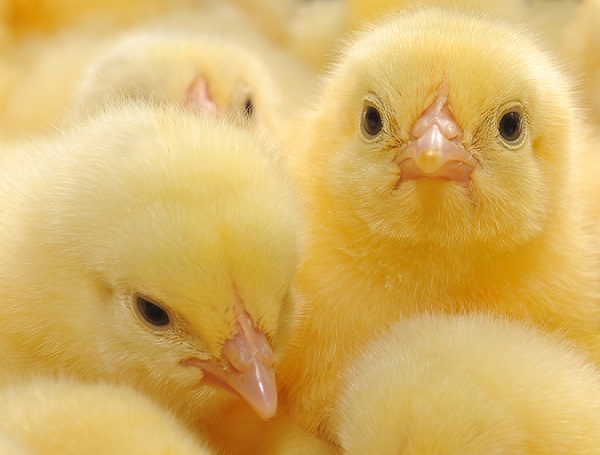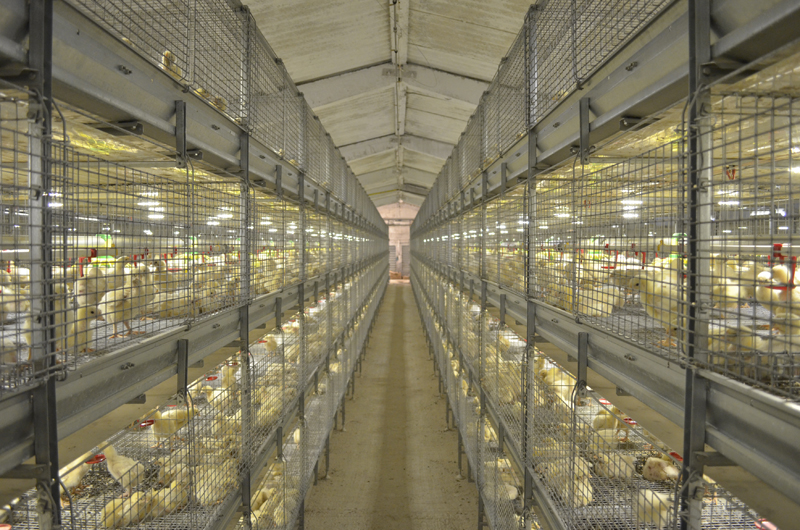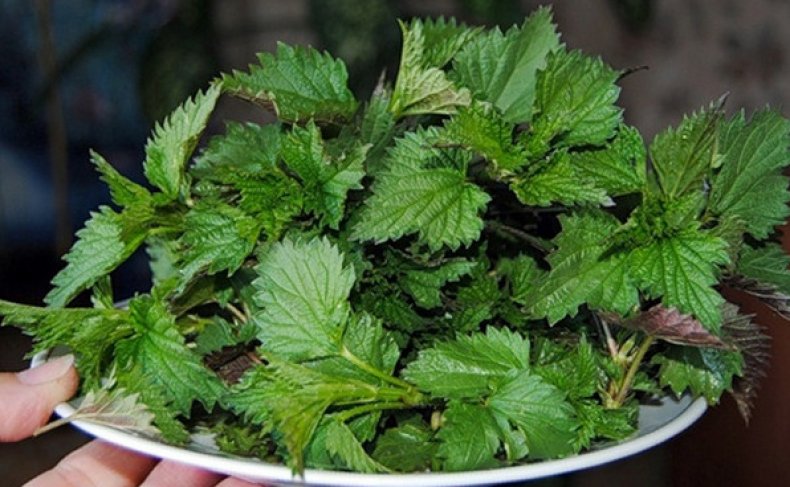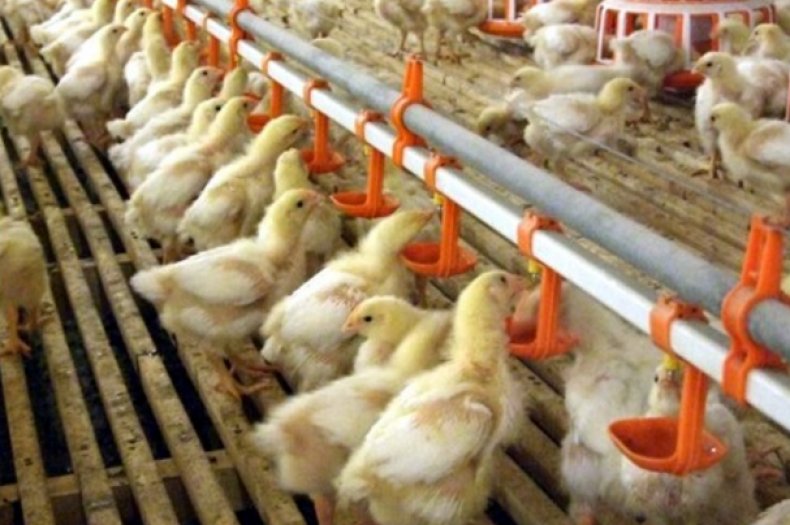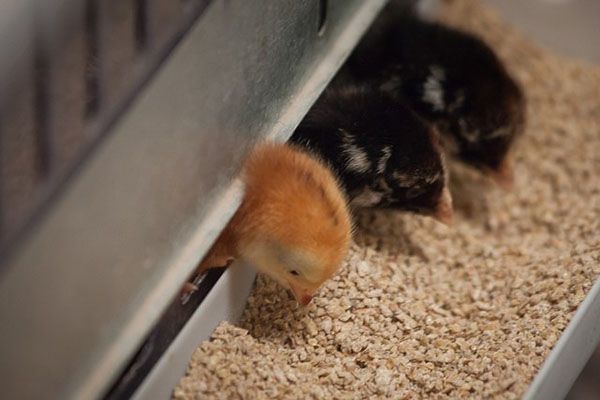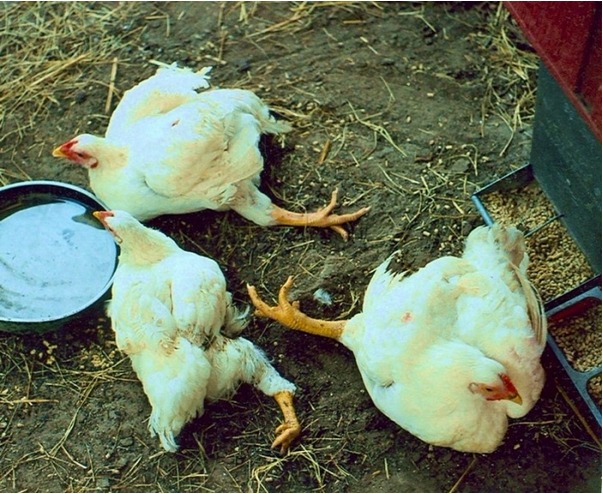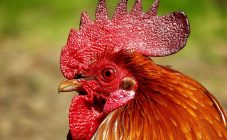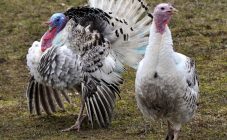Broiler chickens refer to the type of chicken raised for meat. They are characterized by a high growth rate, large build and high taste of meat. Recently, broiler farming has become more and more popular. This is also due to the ability of chickens to quickly gain weight. By the end of the 8th week, the individual grows to 2-2.5 kg of live weight. Careful regular grooming and a well-balanced diet are key to a healthy, robust herd.
Features of broiler care
Within 70 days, chickens are actively gaining weight, reaching maximum weight. After this period, the physiological growth processes slow down. However, the bird continues to consume feed at the same level. If individuals will not be used for breeding, then keeping birds longer than 1.5 months is not profitable.
There are two ways to keep broilers: in the house and in the cage.
When keeping chickens in the house, the following conditions must be met. The room itself must be isolated from external climatic factors. The floor surface should be dry and warm, covered with a layer of dried sawdust.
It is imperative that chicks be disinfected before they are introduced into the house:
- rinse all surfaces, dry;
- cover the floor with slaked lime, based on a proportion of 0.5-1 kg per 1 sq. meter of surface;
- pour a 10 cm layer of sawdust on top of the lime;
- set humidity indicators at the level of 60-68%;
- make constantly running ventilation;
- set the temperature at 26 ° C;
- provide round-the-clock lighting for day-old chicks.
In the first days of chicks' life, their own thermoregulation does not yet allow maintaining the required temperature. Therefore, the room must be constantly warmed up at a level of 26-33 ° C. After 20 days the heating can be reduced to 18-19 ° C.
There are several advantages to using a broiler cage system. Such structures are more compact, they are easier to clean and sanitize. At the same time, it is required to maintain the temperature, humidity, and the level of lighting in the same way as keeping chickens in a poultry house.
The light level plays a special role in the development of chicks. With a lack of light, chicks move less and eat poorly. The more shaded the room, the less viable the offspring will grow. Adults can begin to lose weight. To avoid such negative phenomena during the first 2 weeks after hatching, lighting should be around the clock, subsequently being compared in duration with the natural regime.
An important factor in raising healthy livestock is to provide individuals with the proper volume and quality of feed. To obtain poultry that is suitable in terms of weight, it is important to balance the feed, focusing on the age of the hens.For feeding, there are wet and dry feeds of their preparation and industrial compound feeds.
For the first time after hatching, the chicks should be fed with wet mixtures based on boiled eggs, millet, crushed oats and wheat.
In the third week of growth, boiled potatoes can be introduced, replacing them with up to 1/5 of the volume of cereals. The protein component of the feed provides an active set of muscle mass and skeletal development. You can use curd masses, yogurt or any other dairy product for feeding. Sources of animal protein in the form of meat and bone or fish meal must be present - 5-7 g per 1 individual are required per day, increasing the rate by 2 times with age. Sunflower seed cake and ground legume seeds are used as crops enriched with vegetable proteins for feeding domestic broilers.
From the third day after hatching, chicks need to introduce green feed. In the spring-summer period, it can be succulent herbs, tops of garden crops, grated carrots. The feeding norm is 3-5 g per chick. In the autumn-winter period, instead of fresh herbs, you can introduce grass flour (2-5 g per day for 1 chicken) or sprouted seeds of barley and other cereals.
To prevent symptoms of gastrointestinal problems, chickens can be given:
- a weakly colored solution of potassium permanganate every other day;
- fine gravel, not exceeding 5 mm in size, - it stimulates intestinal peristalsis and promotes the digestion of grain components of feed.
From day 5, chicks can be fed with ground shell and chalk, 2-3 grams per chicken. Mineral additives, like gravel, should not be mixed with other feed ingredients. They should be poured into separate containers that are freely accessible for birds.
Clean water at room temperature should always be provided for drinking. You can use nipple drinkers with fresh water.
To prevent the development of pathogens of infectious diseases, all dishes must be regularly washed and treated with disinfectants.
As a support for a young organism, when the first symptoms of the disease appear, chickens can be given oily solutions of vitamins A, D and E, observing the dosage, according to the instructions. Overdose will cause the chicks to die.
Throughout their lives, chickens should not be deficient in feed. In the first week, chickens need to be fed at least 8 times a day, next week the feeding regime is set as 6 meals a day. From the third week, you can reduce the number of meals to four. Upon reaching the age of one month, chickens can be fed 2 times a day: in the morning and in the evening.
It is necessary to store wet mixtures for a long time only in the refrigerator, since at room temperature deterioration occurs, the multiplication of pathogens and there is the possibility of laying eggs by insects.
To facilitate the feeding process, you can use ready-made industrial feed. They help you gain weight more intensively, fully meeting the needs of a growing body. These feeds vary in pellet size and composition. The most popular is the three-stage system, designed for all ages of chickens: from hatching to slaughter.
Despite the higher cost, compound feed greatly simplifies the care of chickens. When feeding chicks, food helps to maintain immunity, creating the basis for good health.
In the absence of mandatory keeping conditions, chicks can wheeze and, as a result, die.
Broiler health problems
Despite belonging to birds, broilers can begin to wheeze and cough, suffer from a runny nose.
Novice poultry farmers are often tormented by the question: "Chickens sneeze and wheeze, how to treat?" The main diseases in chickens usually begin with wheezing. After that, a cough develops, chickens begin to sneeze, and wheezing becomes more severe. These signs accompany colds. Ignoring such symptoms will lead to the death of the entire brood.
The most common disease is the common cold, which most often affects birds with weak immunity. The main reason for the development is non-compliance with the temperature regime. Inflammation of the airways, accompanied by swelling of the mucous membranes, in connection with which chickens begin to sneeze, breathe through the mouth and wheeze, is very dangerous. The chicken begins to breathe heavily, open its beak, how to treat it at such a moment? For the period of treatment, the air temperature in the house should be maintained above 15 ℃, instead of water, leave, according to the folk method of treatment, a decoction of nettle. Spray Izatizon indoors or use specialized smoke bombs to facilitate the breathing of birds.
A similar symptomatology accompanies mycoplasmosis, a fungal disease that develops with increased dampness. Broilers begin to snort and gasp. Spores entering the respiratory tract can infect all livestock. Most often, antibiotics are used for treatment (streptomycin, erythromycin, lincomycin, etc.).
When broiler chickens wheeze and die what to do, the veterinarian will tell you. Antibiotics should be added to feed at a dosage of 2 g per 10 kg feed. Lack of treatment will lead to the death of the entire chicken population.
How to treat broller chicks when they wheeze? Wheezing in broilers is manifested in the disease - colibacillosis. The disease ends in the death of chickens, and the surviving individuals are delayed in development. The use of such meat is impossible, since residual doses of antibiotics remain in the muscle mass.
Sneezing of broiler chicks must be treated immediately, as delaying can lead to bronchitis. Streptomycin should be rubbed into the open nostrils of chickens. For prevention, all livestock should be drunk with levomycytin or tetracycline at the rate of 1 tablet per 1 liter of water.
There are many reasons why broiler chickens wheeze:
- violation of conditions of detention;
- unbalanced diet;
- obstruction of the stomach with inedible items;
- infectious or viral particles;
- poisoning with nitrates, which are rich in some foods (beets, greens);
- toxic gastric dyspepsia - hypovitominosis of vitamins A, group B and a lack of minerals (calcium, phosphorus).
Tips & Tricks
If a bird with non-standard behavior is seen in the flock while feeding, you should pay more attention to it. Ruffled feathers, a sloppy, downcast look are the first signs for isolating an individual in a separate room. At the same time, it is necessary to analyze the conditions for keeping birds, check temperature sensors and humidity, and sanitize the place of detention.
To prevent the onset of diseases, the litter should be changed frequently: 2 times a day during the cold season, 5 or more times during the warm season. During the process, carefully inspect the new substrate for small pebbles, straw or dry grass.
The first signs of disease can be seen in the chicks' sleeping posture.Normally, they should lie, hiding their legs under them. If you find an unusual position, for example, the chicken began to stretch its legs, or a tremor of the head or neck, you should contact your veterinarian.
Summing up, we can say that broiler chickens attract attention with a quick weight gain (about 2.5 months), the possibility of compact keeping. However, like all animals, it requires some care and careful adherence to optimal conditions. In this case, the chickens will grow up intensively. Regularly calling the veterinarian and carrying out vaccinations will minimize the possibility of contamination of birds with viral or infectious diseases.
Independently you need to constantly monitor and set, according to age, the temperature and humidity in the room. A well-chosen diet will allow the birds to strengthen their immunity. Observing all of the above, broilers will delight you with good health and high taste of meat.
